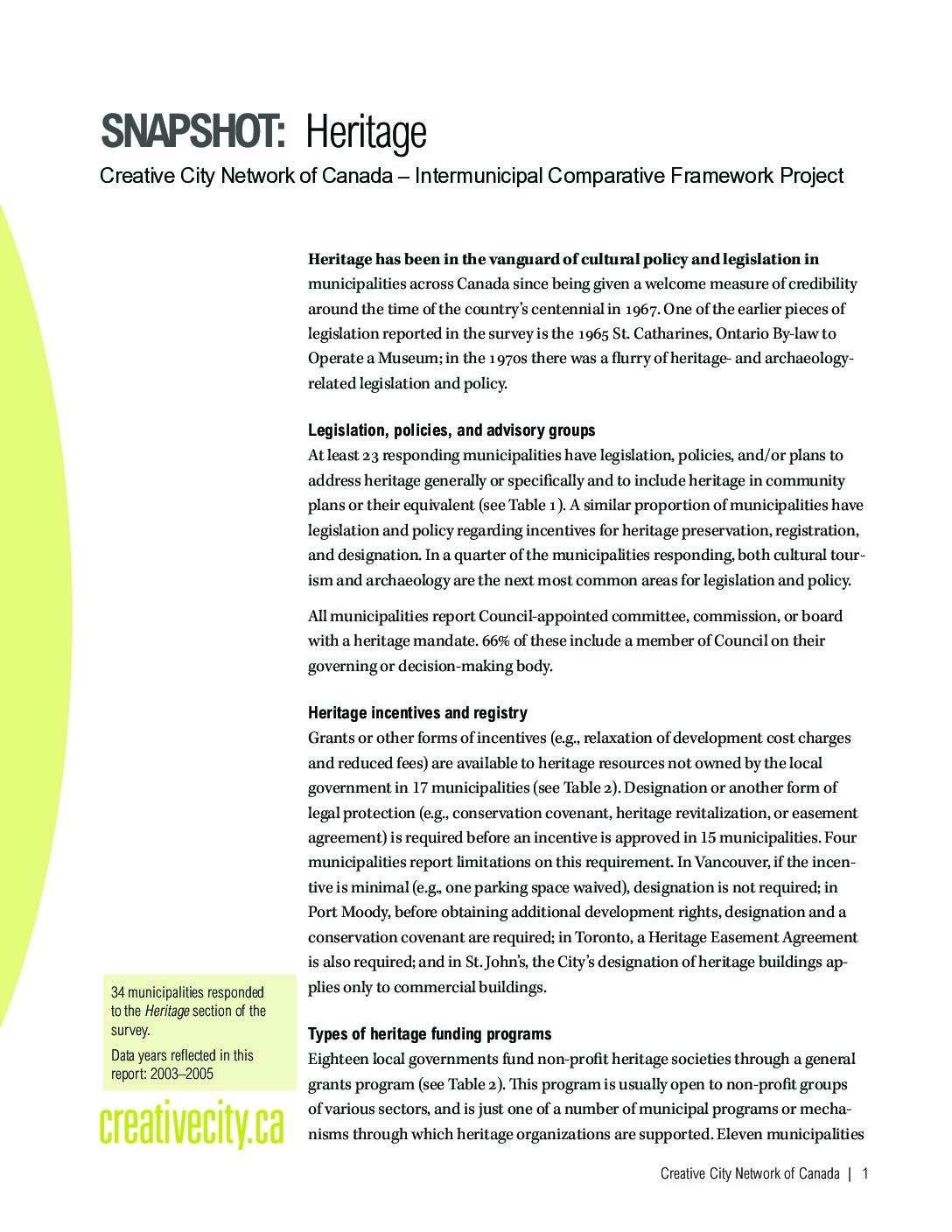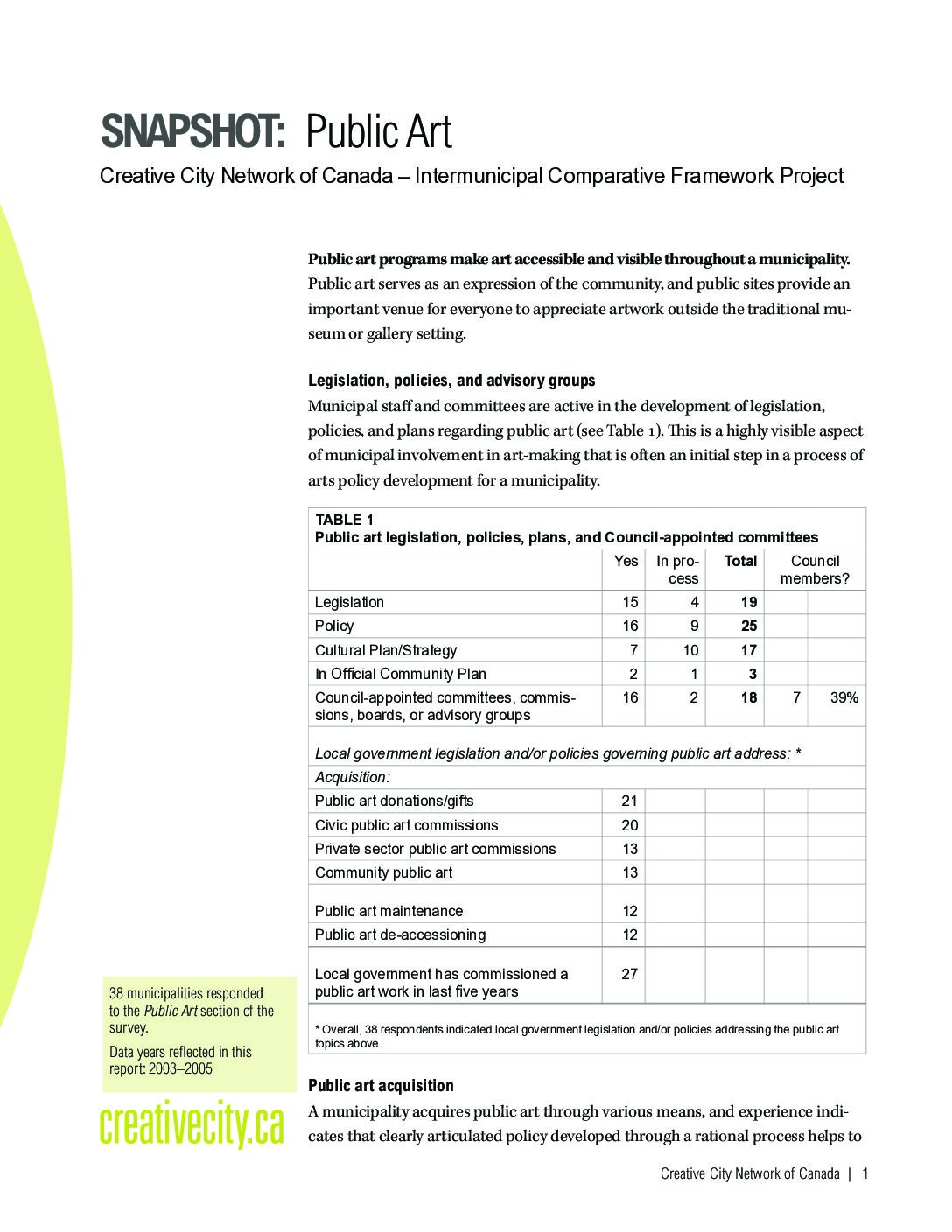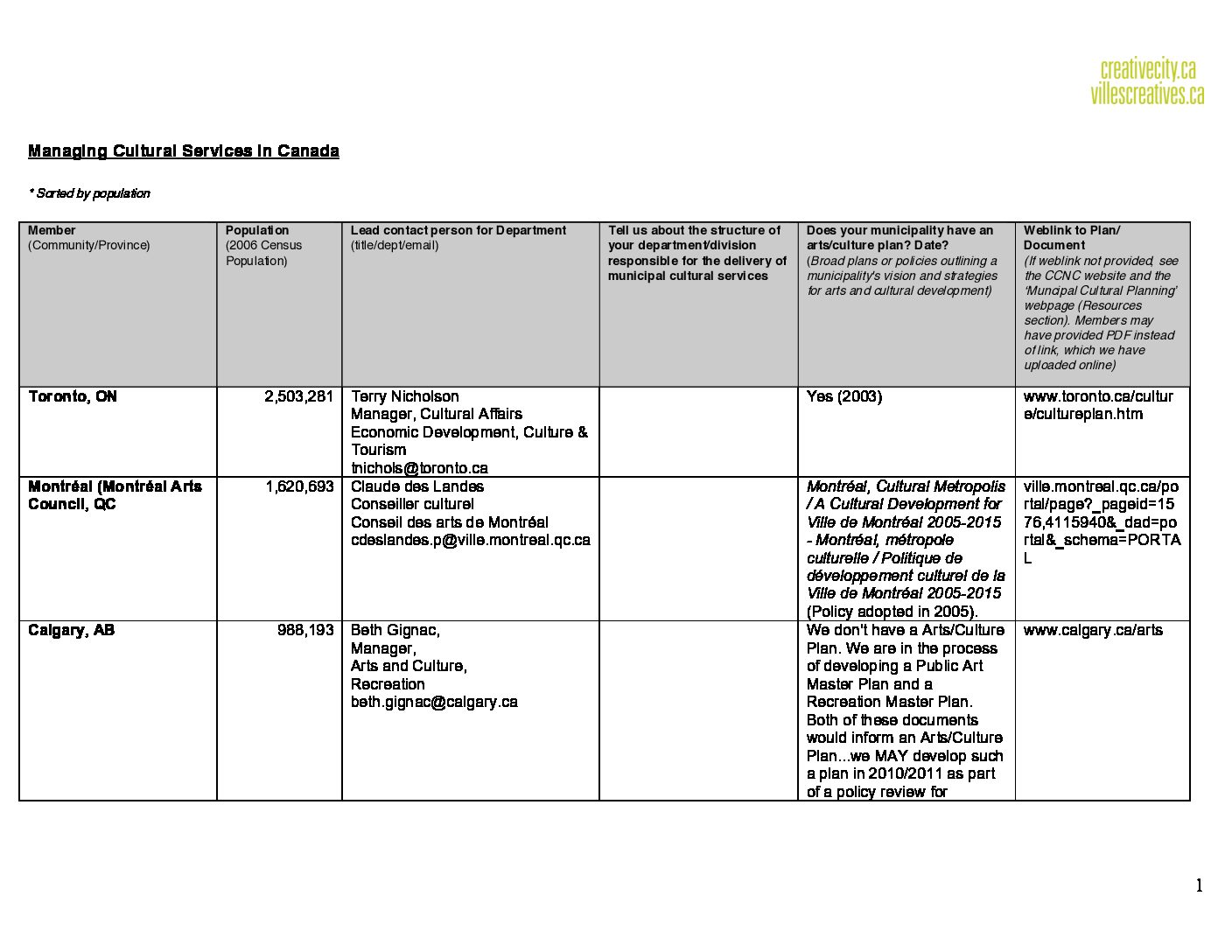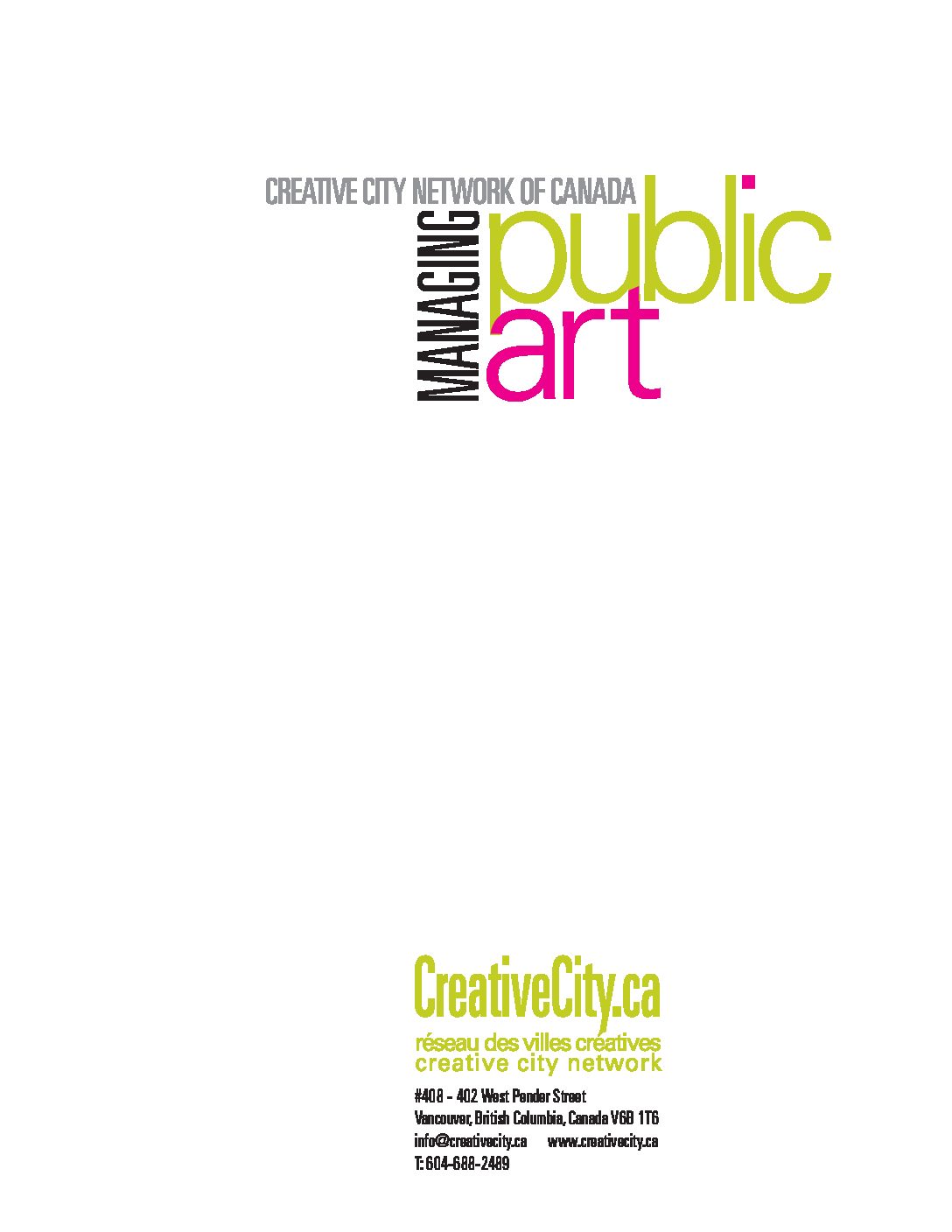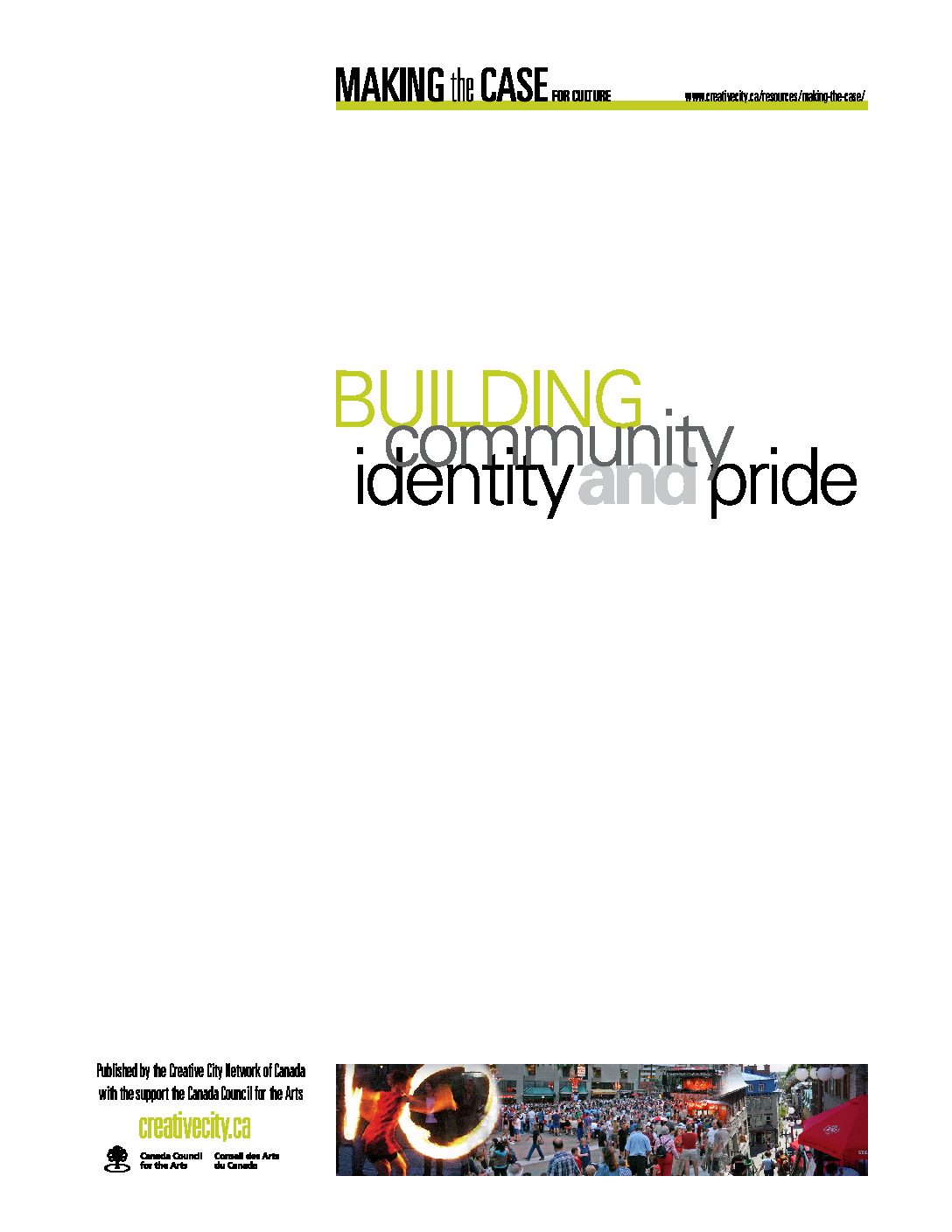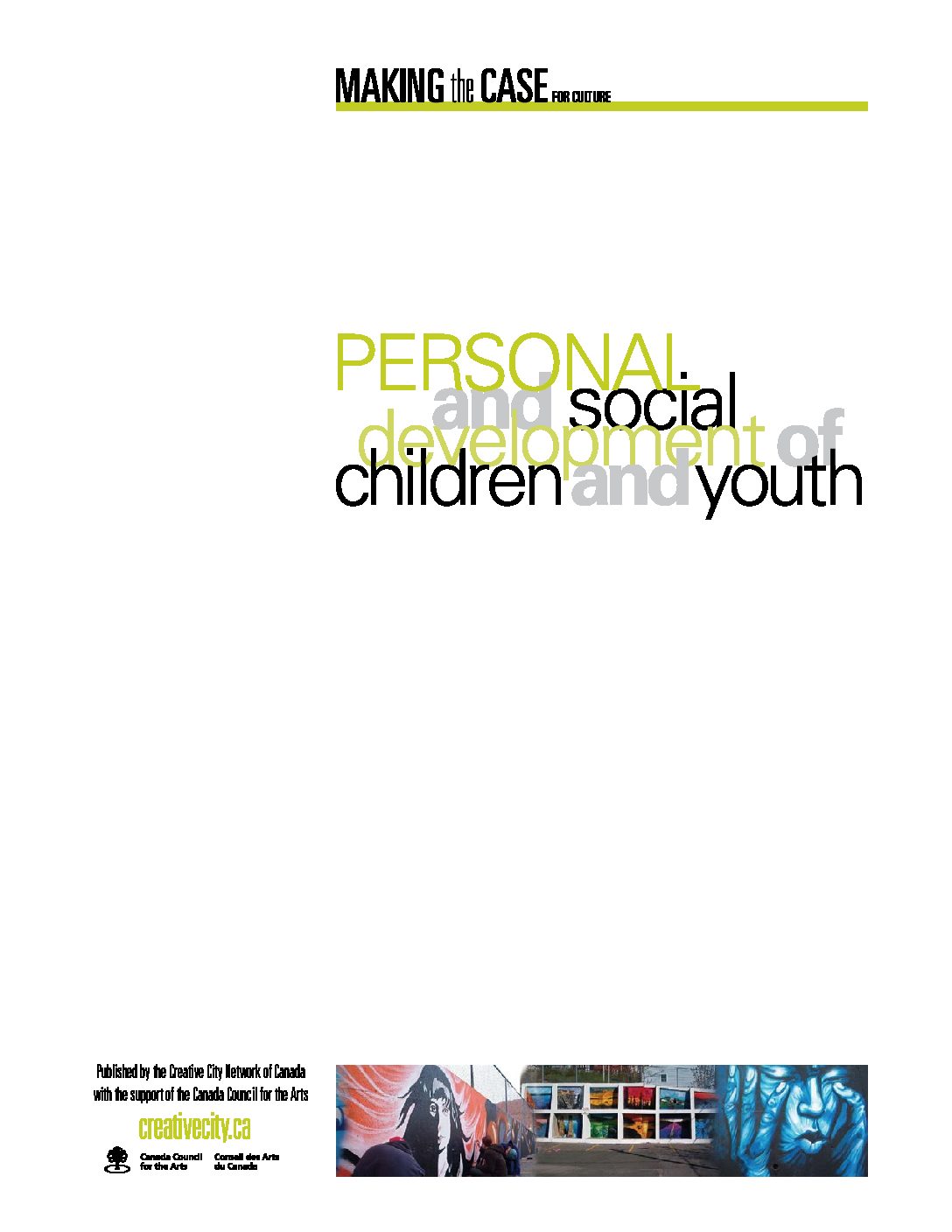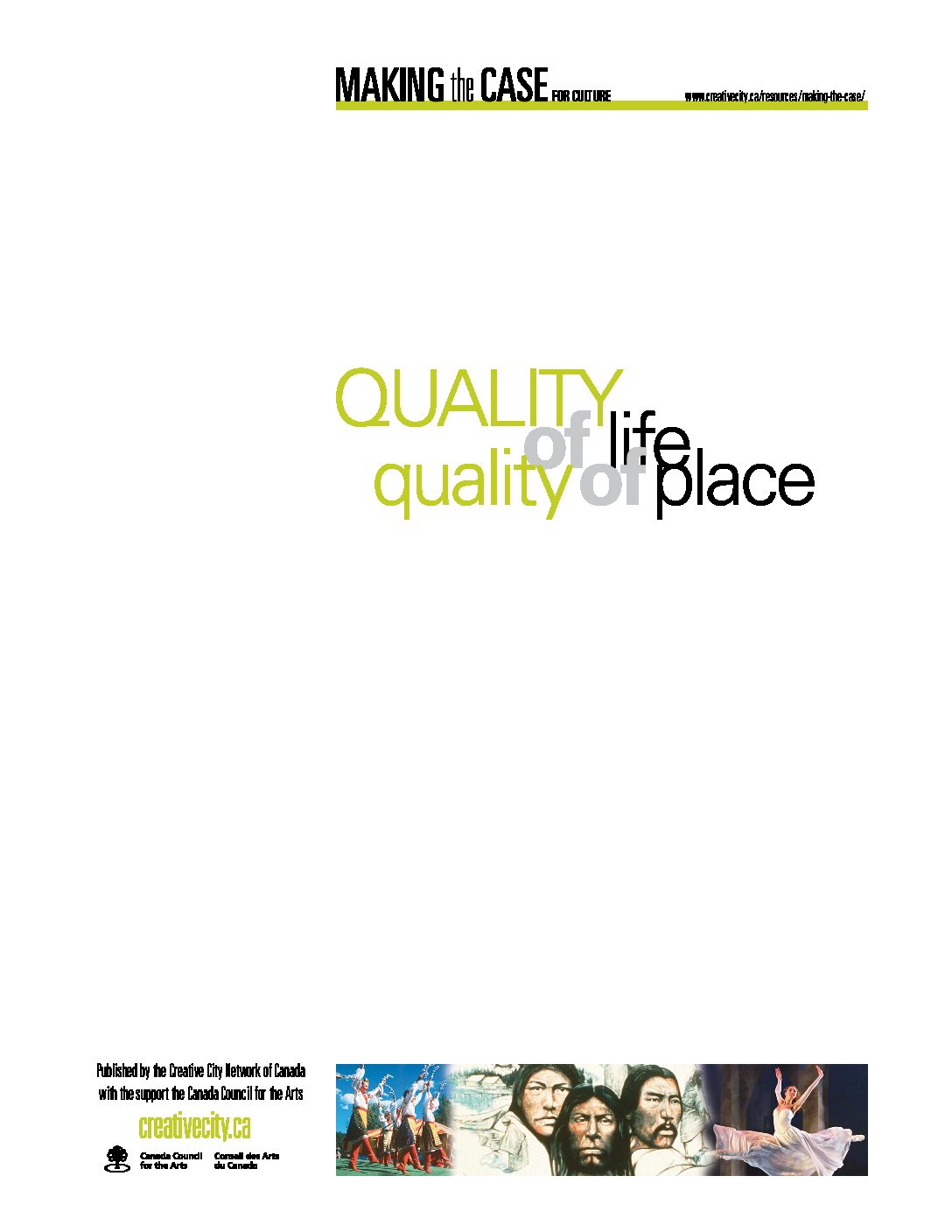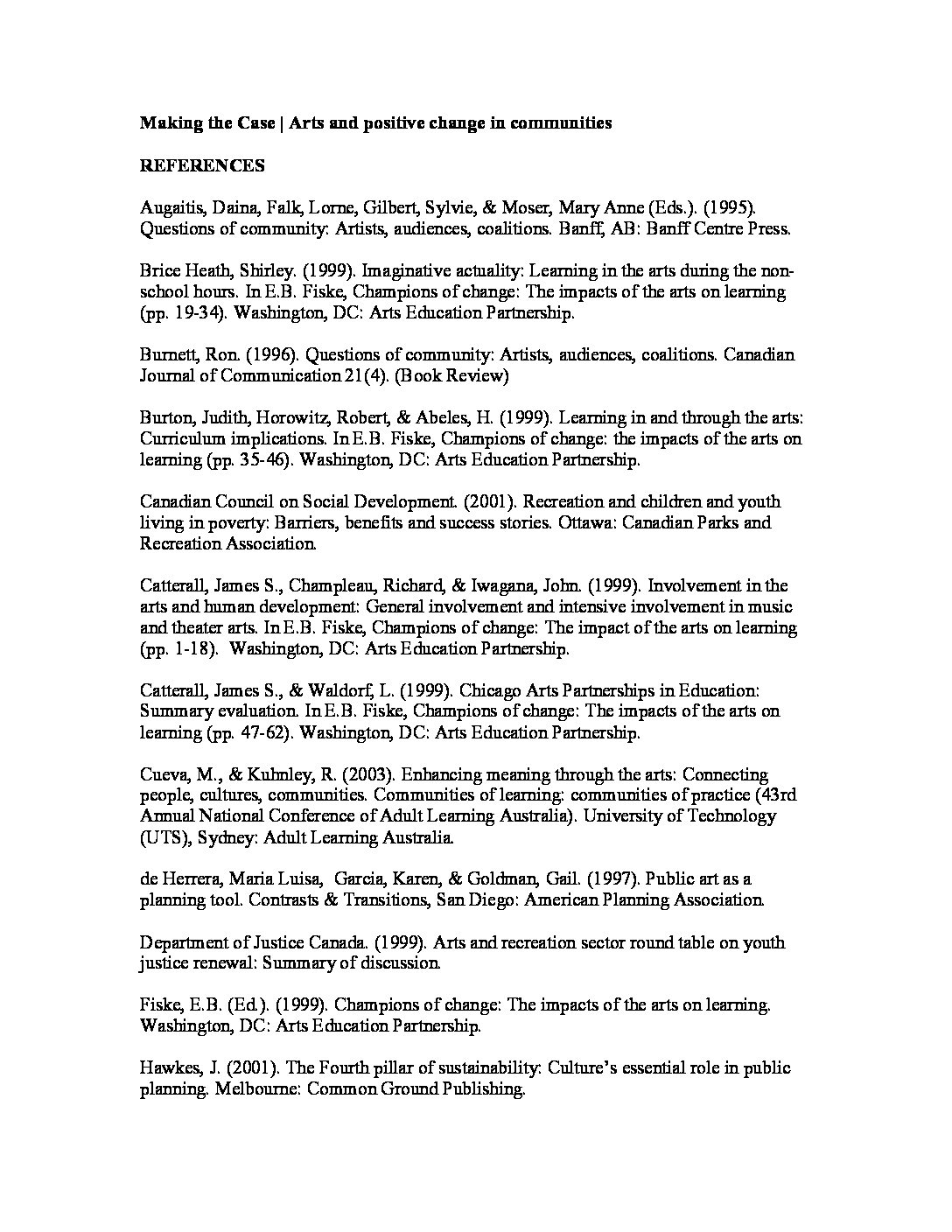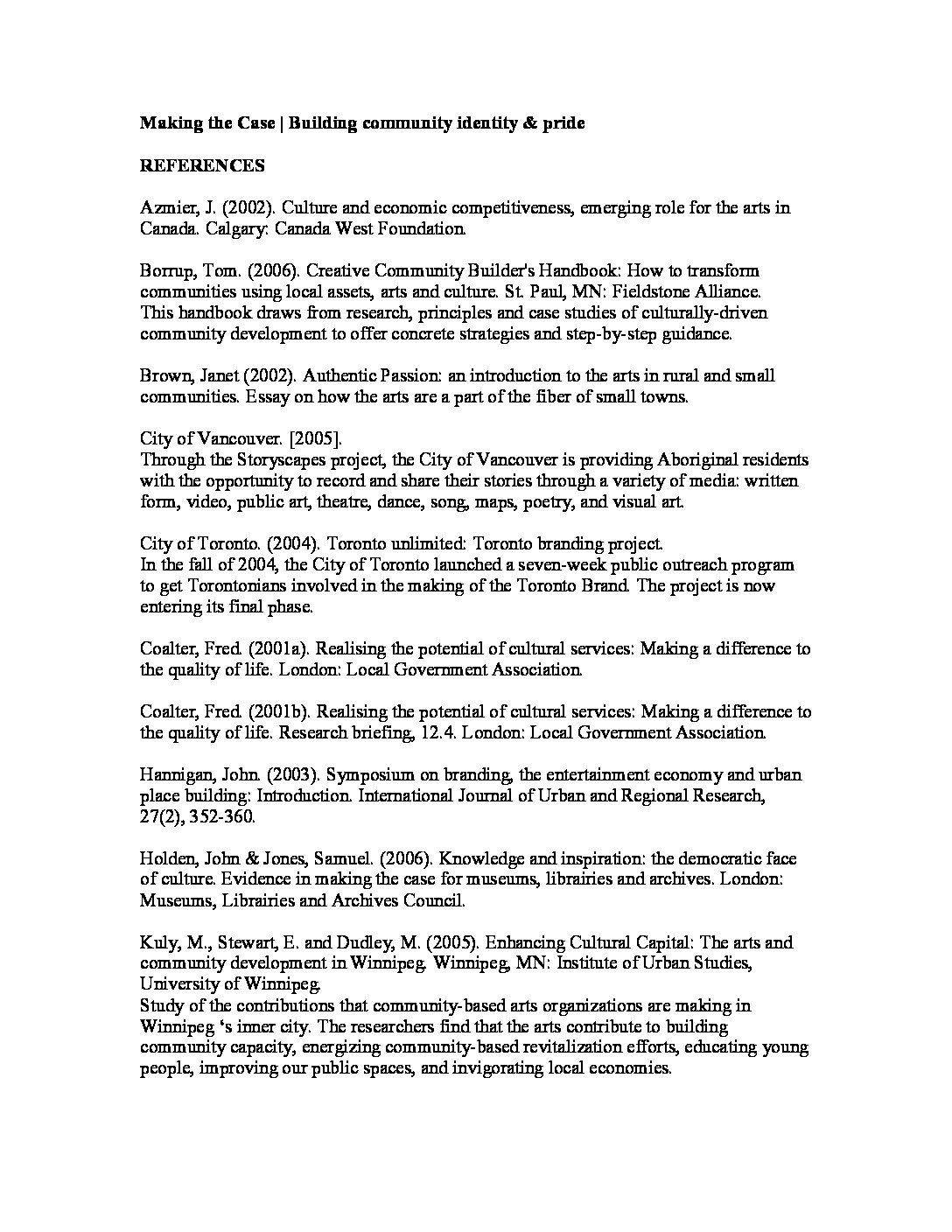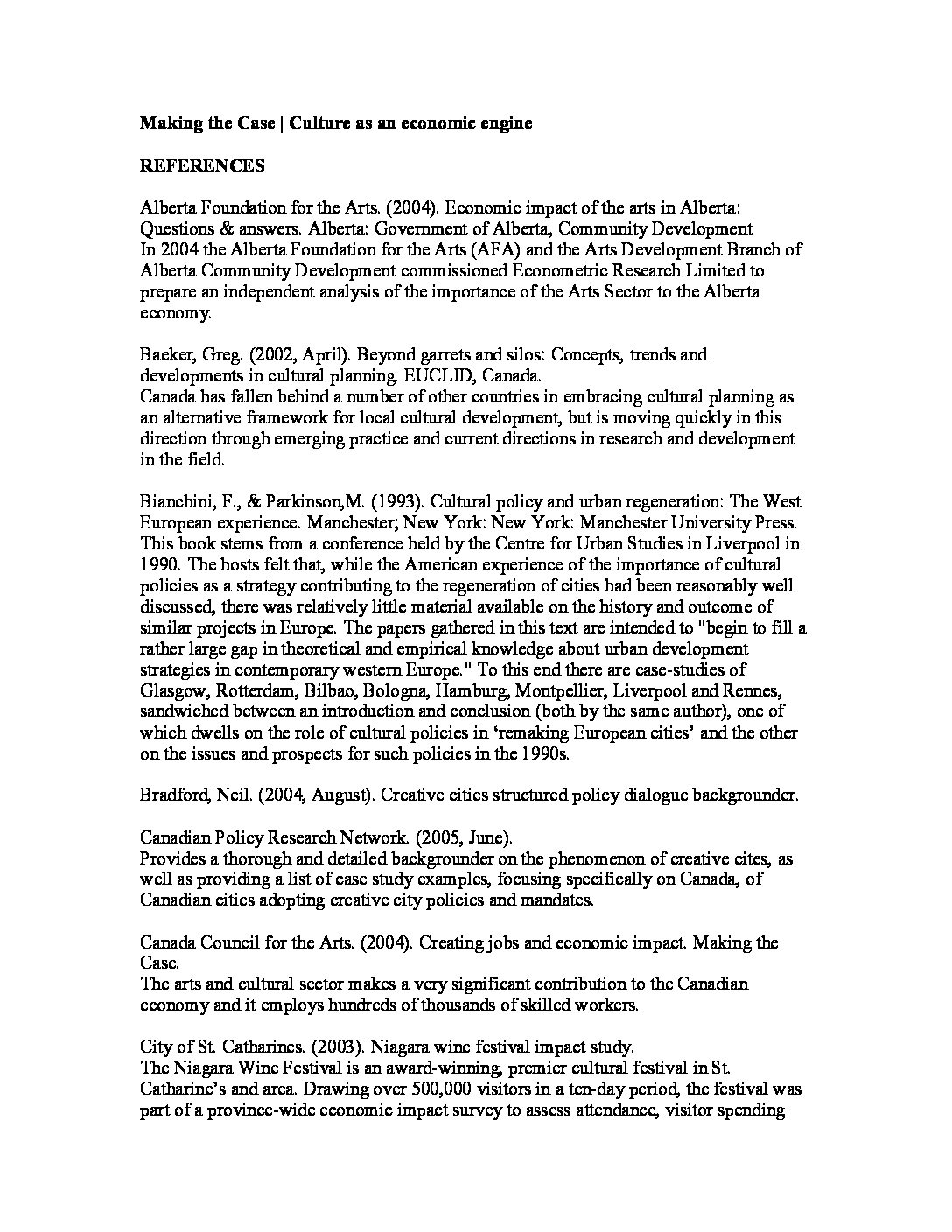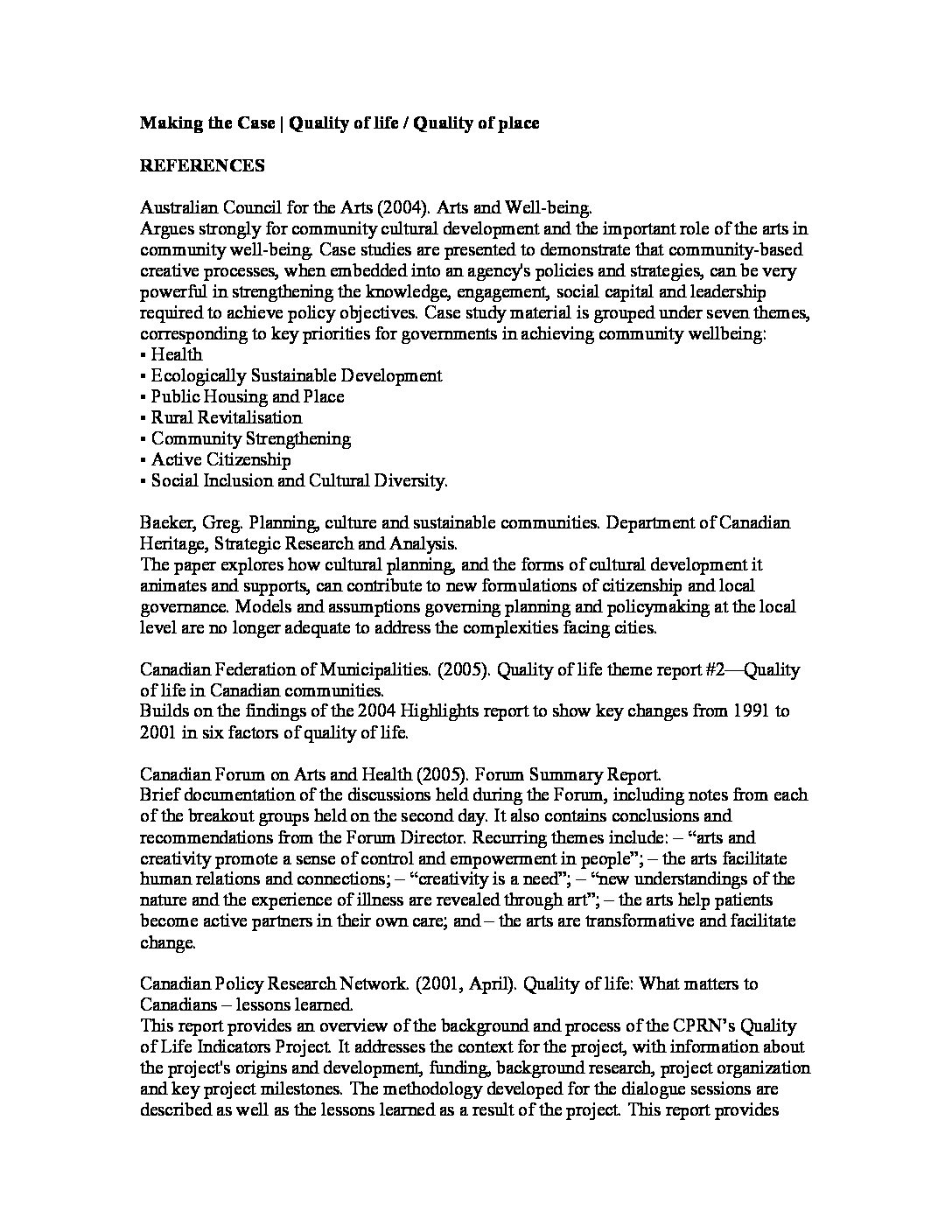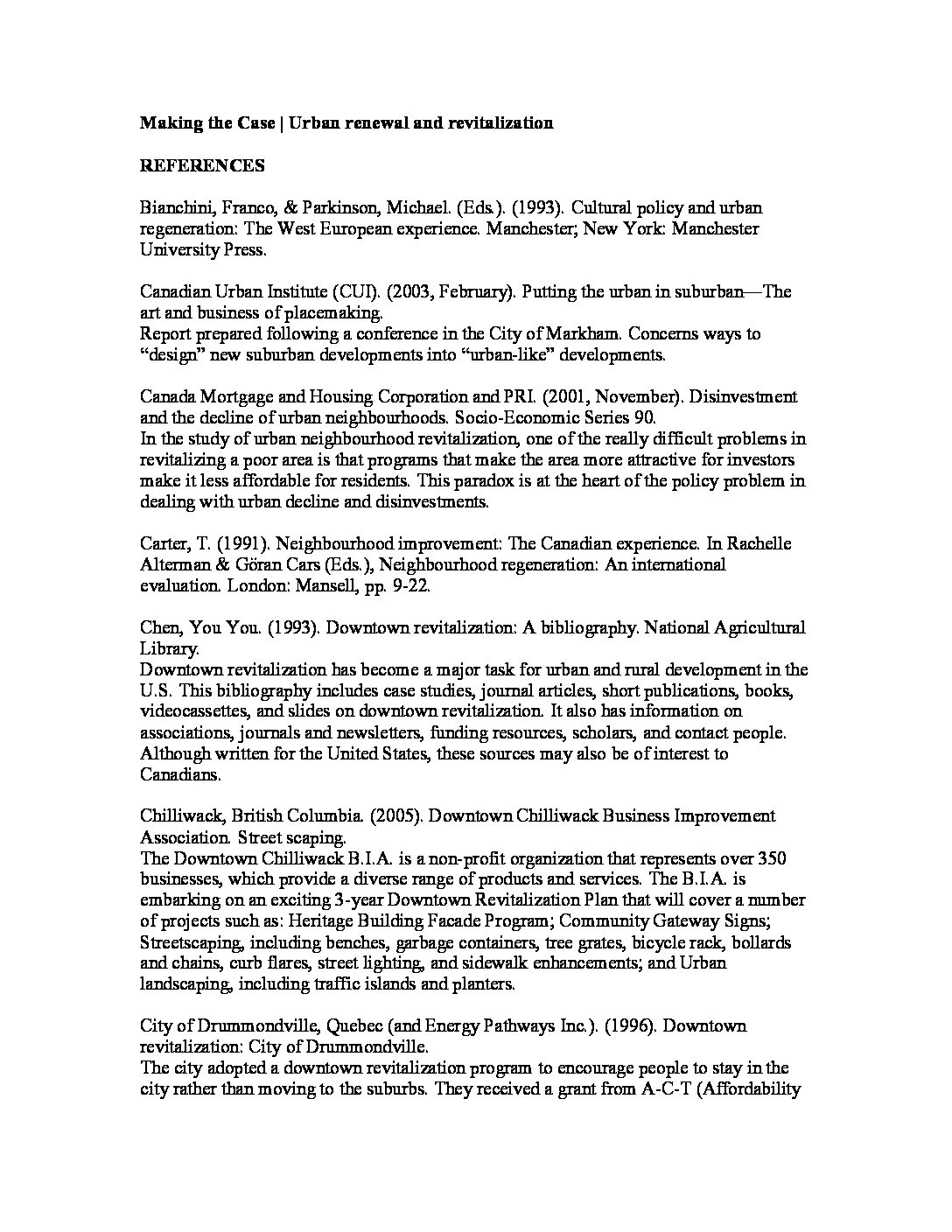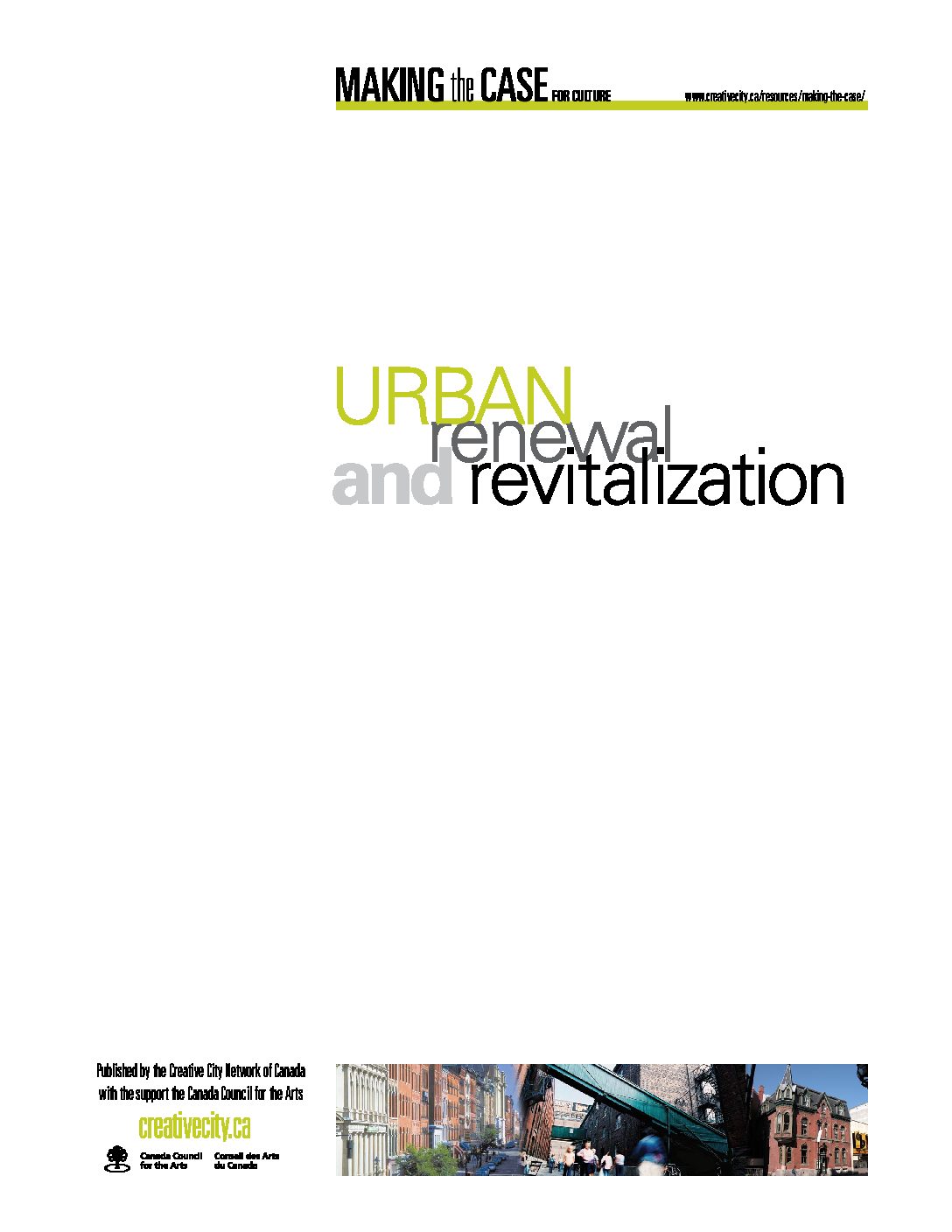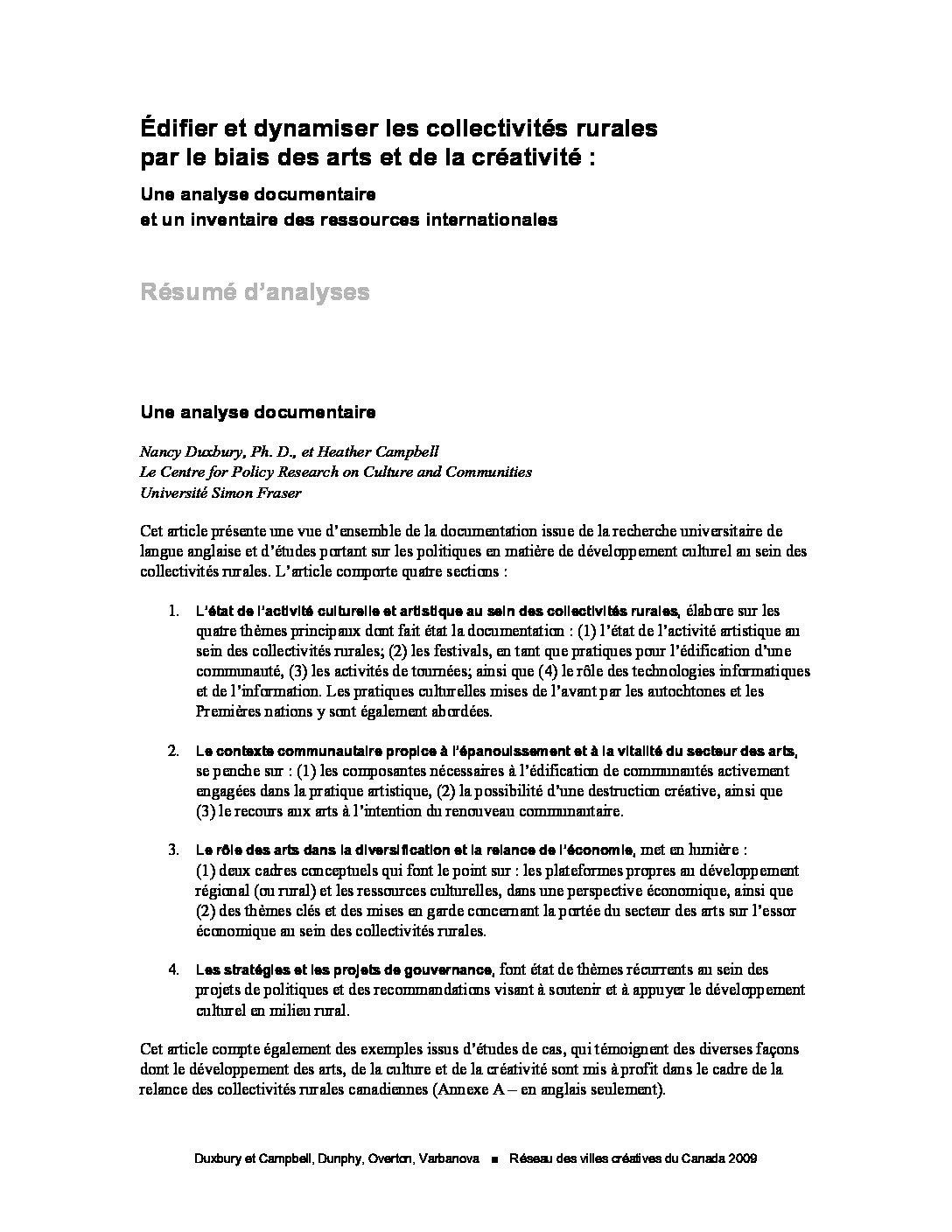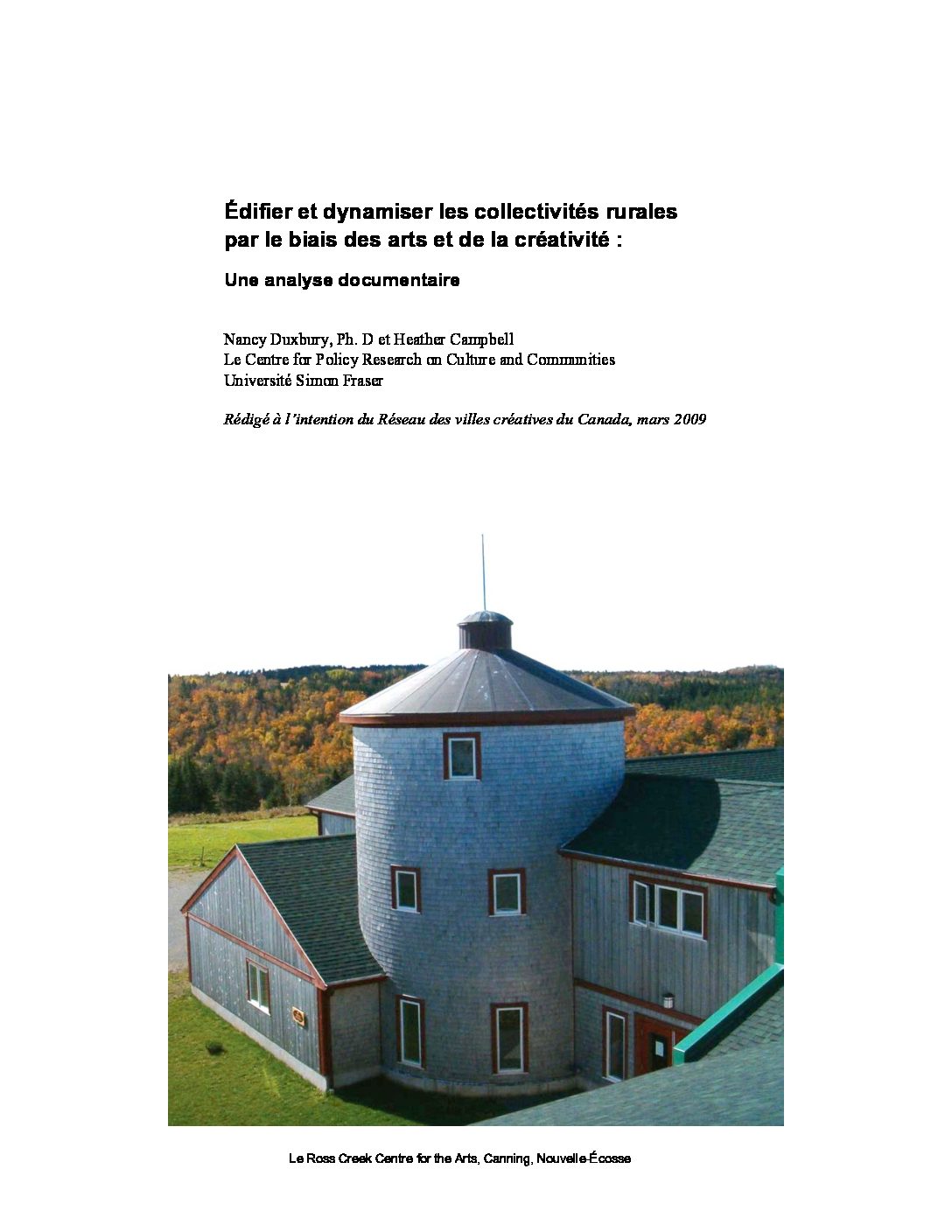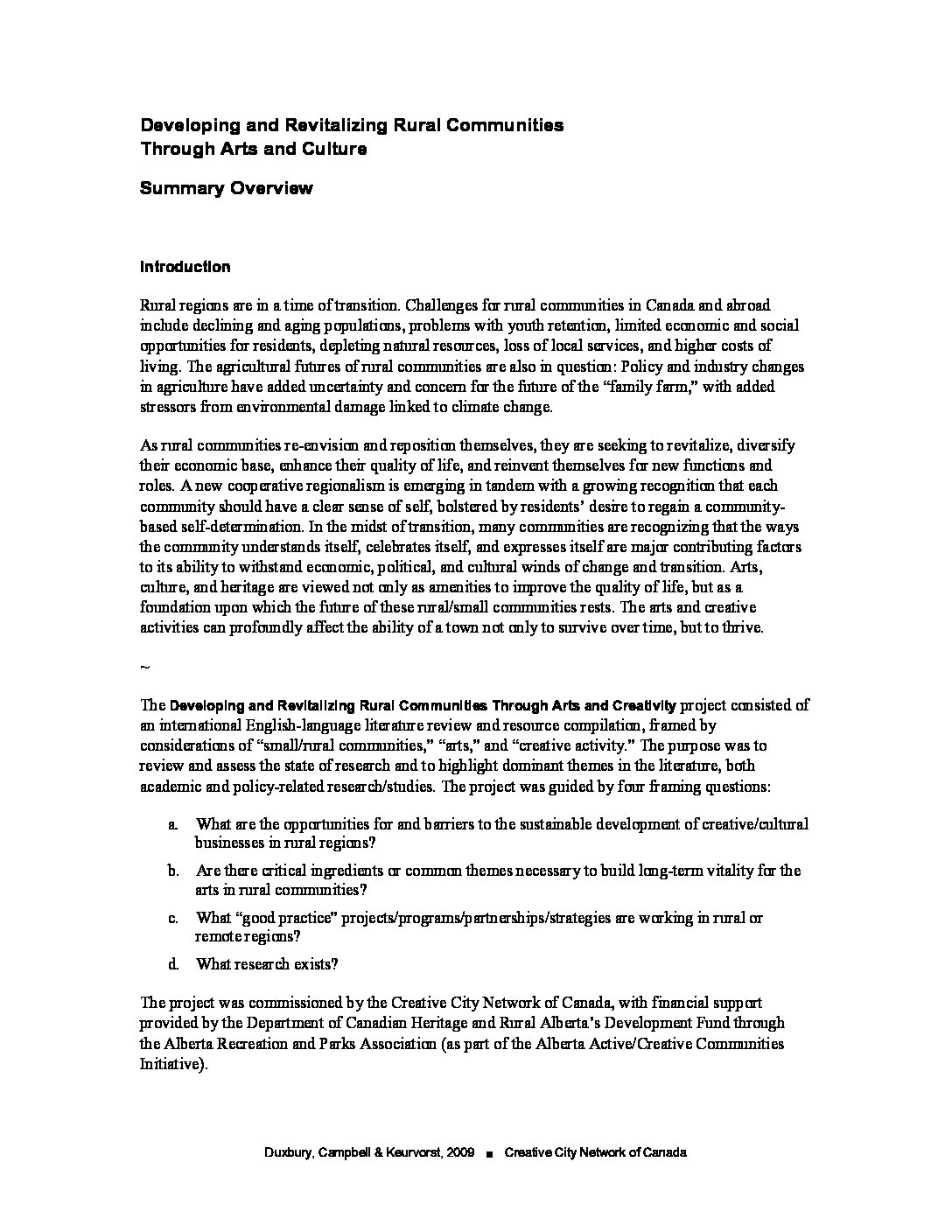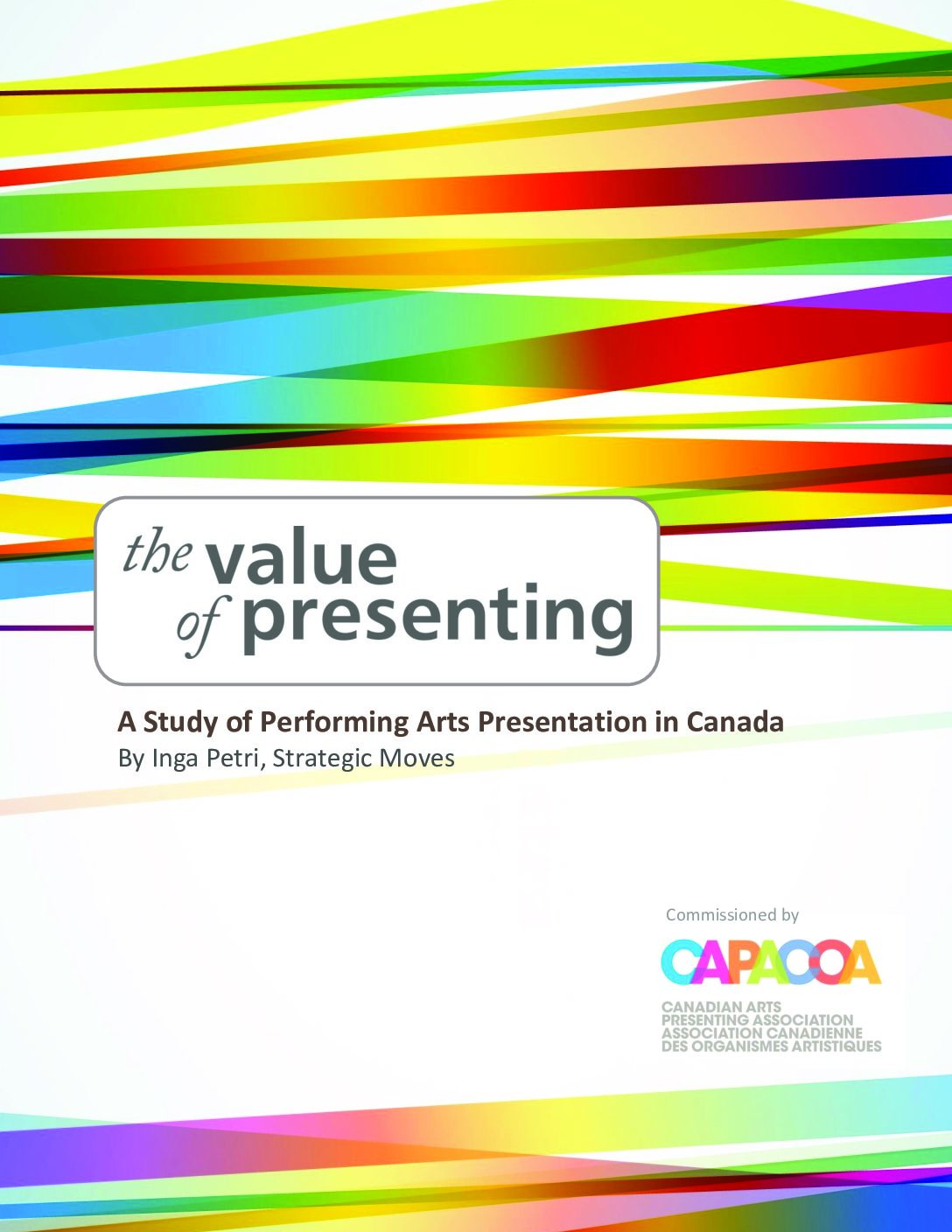CCNC Research
-
In the summer of 2021, CCNC asked Canadians to share stories of culture organizations who changed things up during the pandemic to keep their art on offer, to maintain revenue and audiences, or to find new audiences. We collected over 200 stories from across the country!
In total, over 200 such stories were collected by Hill Strategies Research from all provinces and two territories. The results were completely inspiring and exceptional. The final report documents how artists and organizations stabilized revenue, maintained audiences, or created new streams of revenue during the pandemic. “The artists’ outside-of-the-box thinking demonstrates the strength of Canada’s culture sector. The report as a whole is a storied collection of inspiring Canadian innovation.” – CCNC Executive Director, Kathleen Darby.
The data will be invaluable for every level of government looking to develop programs and policy that supports innovation in the cultural sector.
In Phase Two, new professional development tools for cultural and creative industries were developed in collaboration with project partners, the Cultural Human Resources Council and Les Arts et la Ville. The interactive 3-hour training workshop toured Canadian municipalities in 2022 and 2023 and was delivered in both official languages to arts and culture organizations across the country. The workshop was delivered in both official languages through virtual event and live streamed to YouTube.
Watch the Workshop in English.
Regarder l’atelier en français.
Project Partners:
- Canadian Commission for UNESCO
- Cultural Human Resources Council
- Les Arts et la Ville
Funded by the Government of Canada.
“This work reminds us that the arts nourish our communities and help us confront difficult times
together with courage and open hearts.” — Roda Muse, Secretary General, CCUNESCO -
-
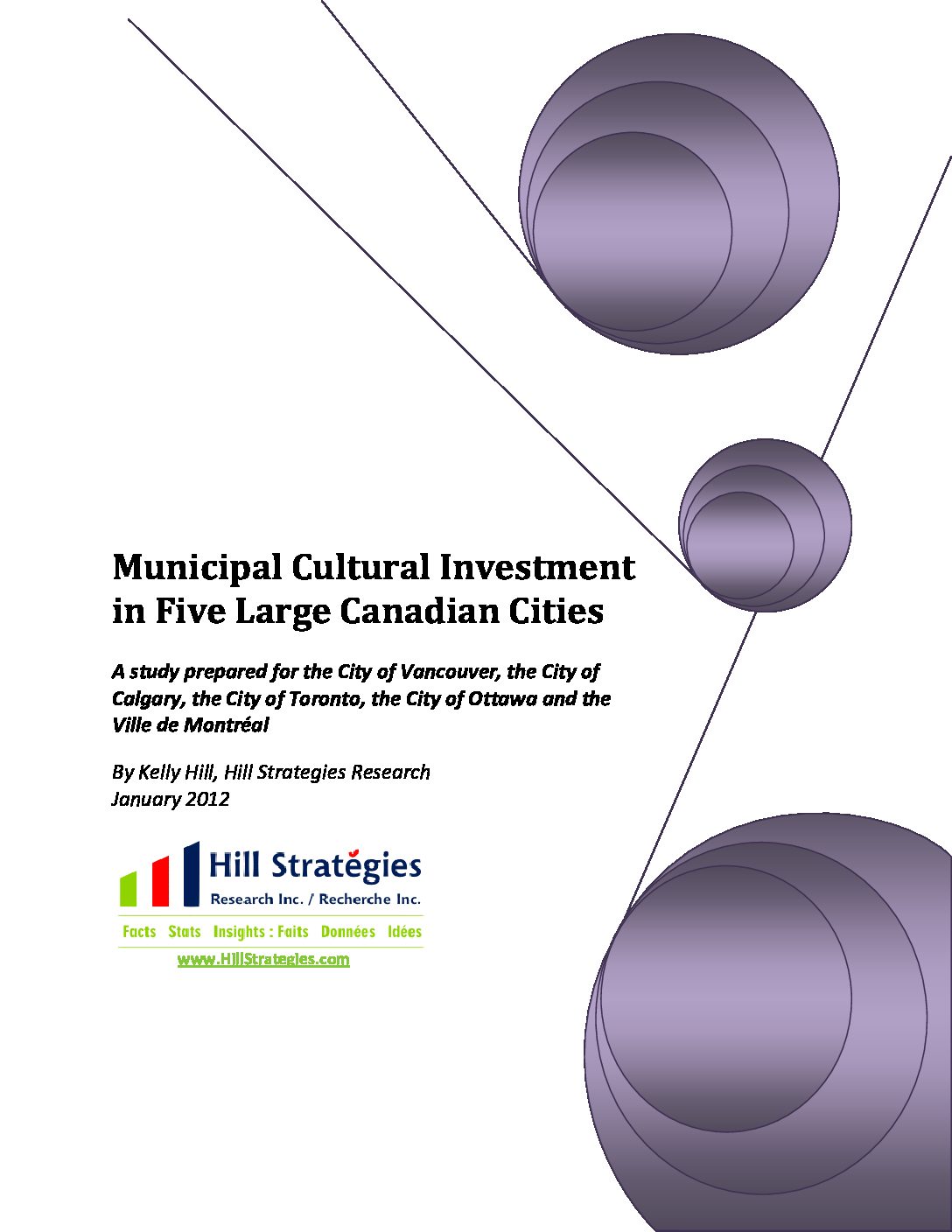
Municipal Cultural Investments in Five Large Canadian Cities
A study prepared for the City of Vancouver, the City of Calgary, the City of Toronto, the City of Ottawa and the Ville de Montréal. By Kelly Hill, Hill Strategies Research, January 2012. This report compares the cultural investment in five of Canada’s largest cities: Vancouver, Calgary, Toronto, Ottawa and Montréal. This report is the product of a collaborative effort between cultural staff members in the five large cities, a collaboration that was made possible thanks to the work of the Creative City Network of Canada.
-
-
-

Executive Summary
The Intermunicipal Comparative Framework: An inventory of local government support to cultural development Executive Summary.
The Intermunicipal Comparative Framework Project is a means to inventory and understand the infrastructure, scope, and nature of local government involvement in cultural development across Canada. It creates the structure to capture the nature of local government involvement and investment in cultural development nationally. “Cultural development” is used here in an inclusive sense, and topics addressed in the project include arts, heritage, facilities, civic art collections, public art, funding, non-monetary support, and more.
-
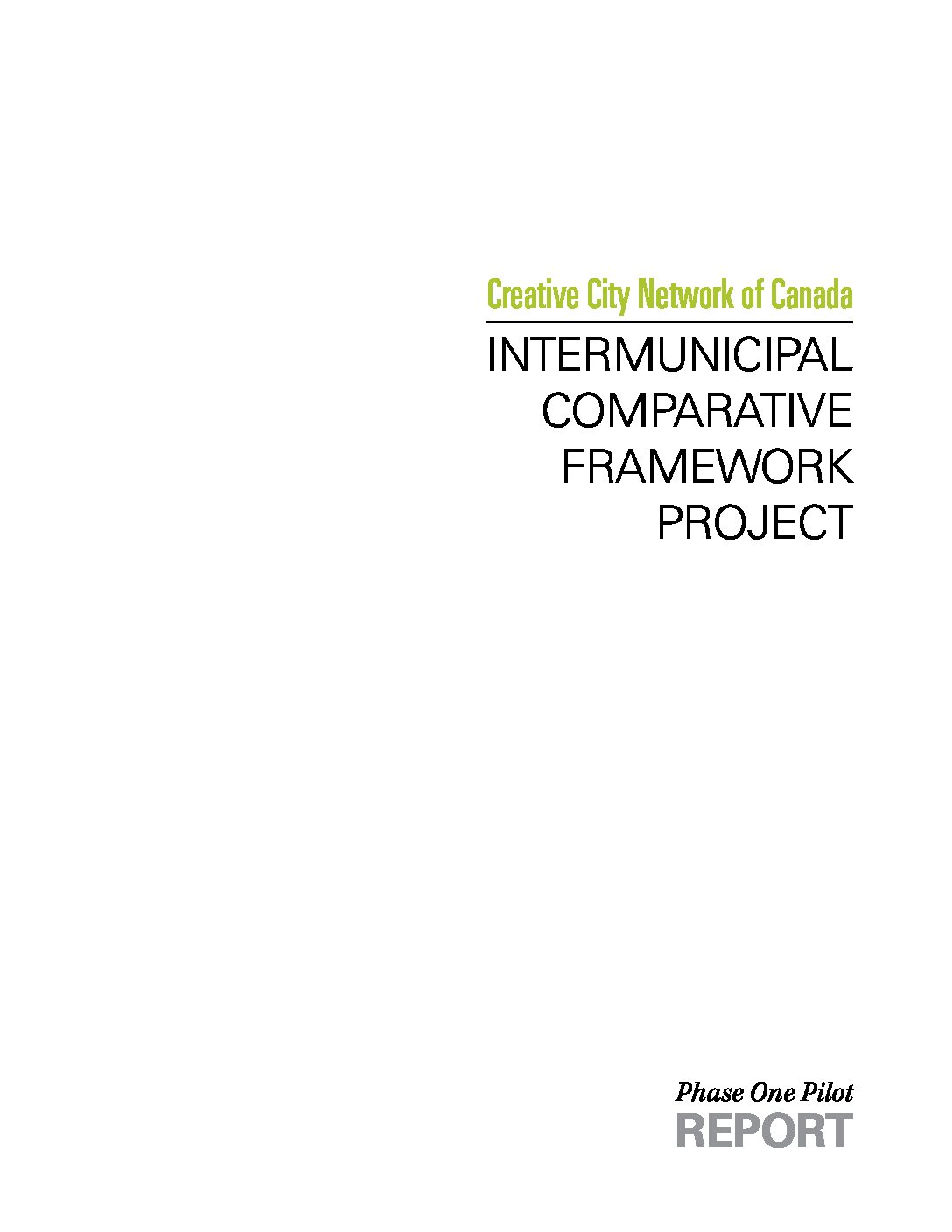
Phase One Pilot Report
The Intermunicipal Comparative Framework: An inventory of local government support to cultural development Phase One Pilot Report
The Intermunicipal Comparative Framework Project is a means to inventory and understand the infrastructure, scope, and nature of local government involvement in cultural development across Canada. It creates the structure to capture the nature of local government involvement and investment in cultural development nationally. “Cultural development” is used here in an inclusive sense, and topics addressed in the project include arts, heritage, facilities, civic art collections, public art, funding, non-monetary support, and more.
-
-
-
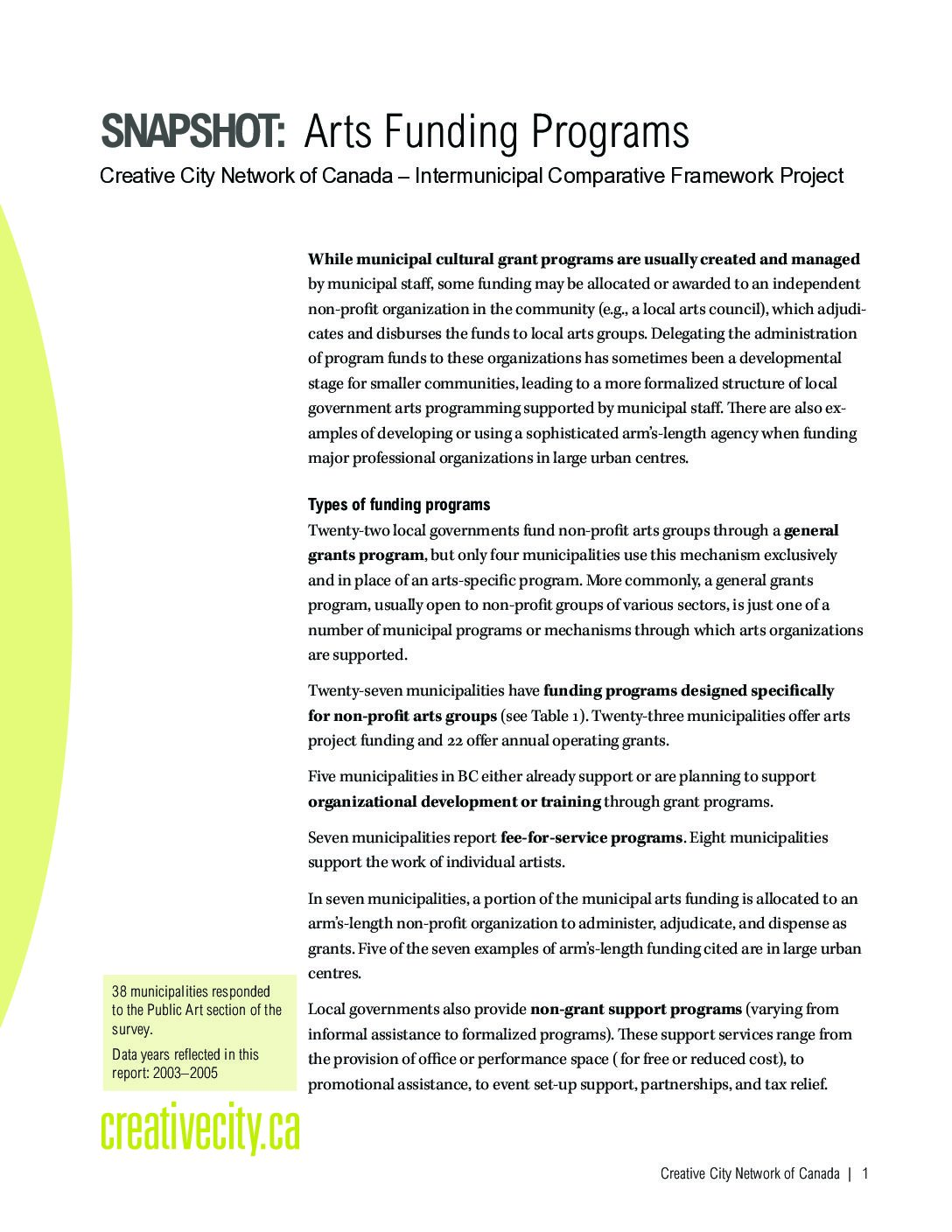
Snapshot: Arts Funding Programs
The Intermunicipal Comparative Framework: An inventory of local government support to cultural development; Snapshot: Arts Funding Programs
The Intermunicipal Comparative Framework Project is a means to inventory and understand the infrastructure, scope, and nature of local government involvement in cultural development across Canada. It creates the structure to capture the nature of local government involvement and investment in cultural development nationally. “Cultural development” is used here in an inclusive sense, and topics addressed in the project include arts, heritage, facilities, civic art collections, public art, funding, non-monetary support, and more.”
While municipal cultural grant programs are usually created and managed by municipal staff, some funding may be allocated or awarded to an independent non-profit organization in the community (e.g., a local arts council), which adjudicates and disburses the funds to local arts groups. Delegating the administration of program funds to these organizations has sometimes been a developmental stage for smaller communities, leading to a more formalized structure of local government arts programming supported by municipal staff. There are also examples of developing or using a sophisticated arm’s-length agency when funding major professional organizations in large urban centres. 38 municipalities responded to the Public Art section of the survey. Data years reflected in this report: 2003–2005
-
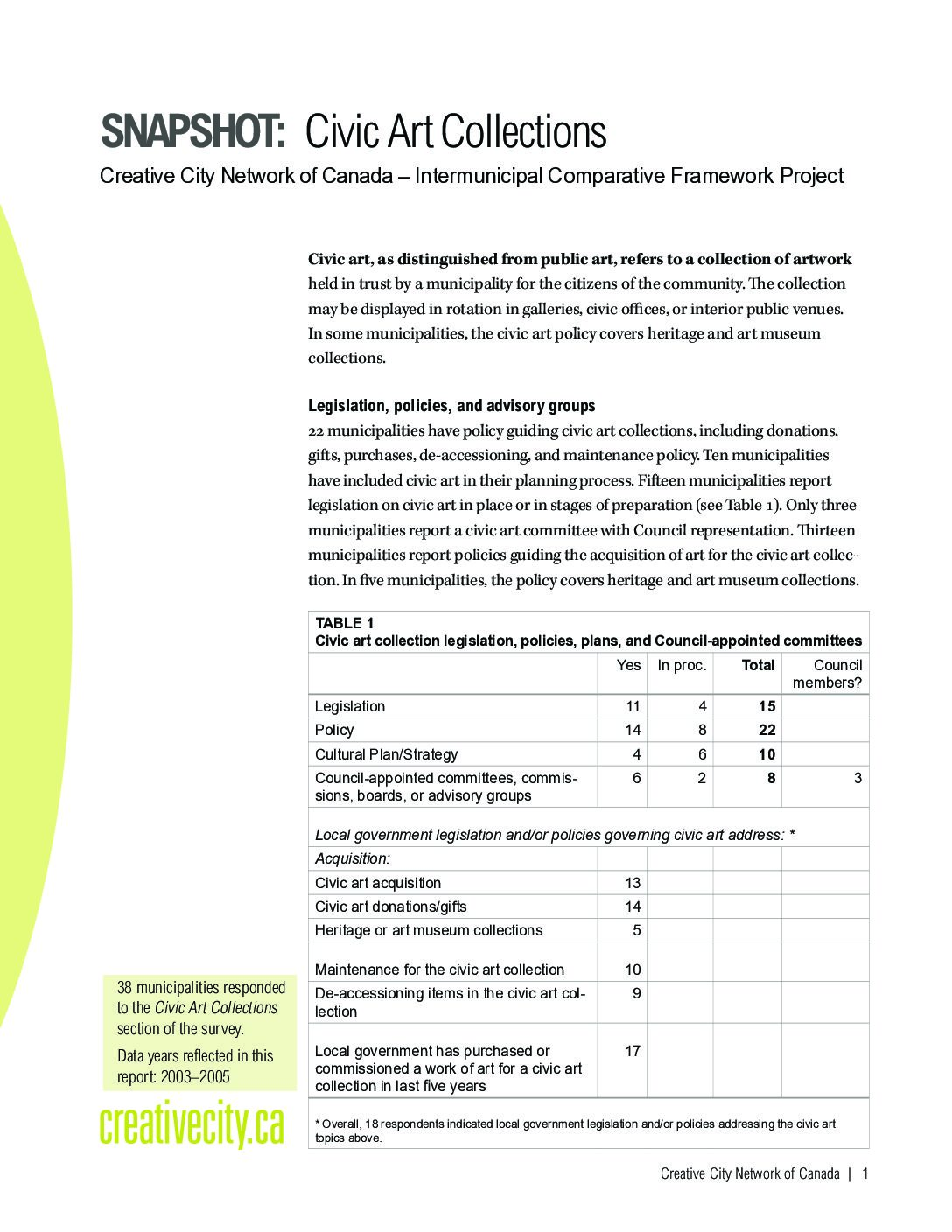
Snapshot: Civic Art Collections
The Intermunicipal Comparative Framework: An inventory of local government support to cultural development; Snapshot: Civic Art Collections
The Intermunicipal Comparative Framework Project is a means to inventory and understand the infrastructure, scope, and nature of local government involvement in cultural development across Canada. It creates the structure to capture the nature of local government involvement and investment in cultural development nationally. “Cultural development” is used here in an inclusive sense, and topics addressed in the project include arts, heritage, facilities, civic art collections, public art, funding, non-monetary support, and more.
Civic art, as distinguished from public art, refers to a collection of artwork held in trust by a municipality for the citizens of the community. The collection may be displayed in rotation in galleries, civic offices, or interior public venues. In some municipalities, the civic art policy covers heritage and art museum collections.
-
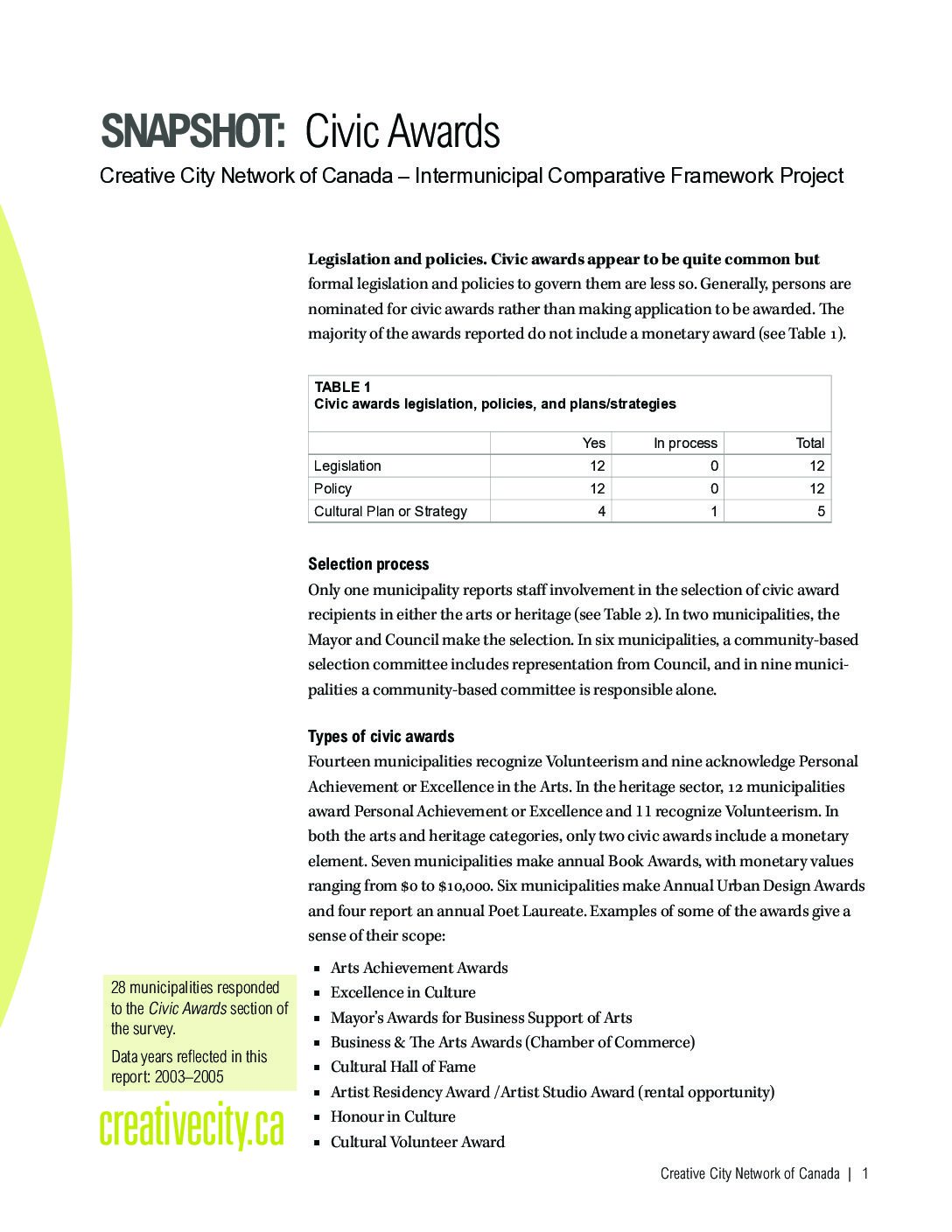
Snapshot: Civic Awards
The Intermunicipal Comparative Framework: An inventory of local government support to cultural development; Snapshot: Civic Awards
The Intermunicipal Comparative Framework Project is a means to inventory and understand the infrastructure, scope, and nature of local government involvement in cultural development across Canada. It creates the structure to capture the nature of local government involvement and investment in cultural development nationally. “Cultural development” is used here in an inclusive sense, and topics addressed in the project include arts, heritage, facilities, civic art collections, public art, funding, non-monetary support, and more.
Legislation and policies. Civic awards appear to be quite common but formal legislation and policies to govern them are less so. Generally, persons are nominated for civic awards rather than making application to be awarded. The majority of the awards reported do not include a monetary award.
-
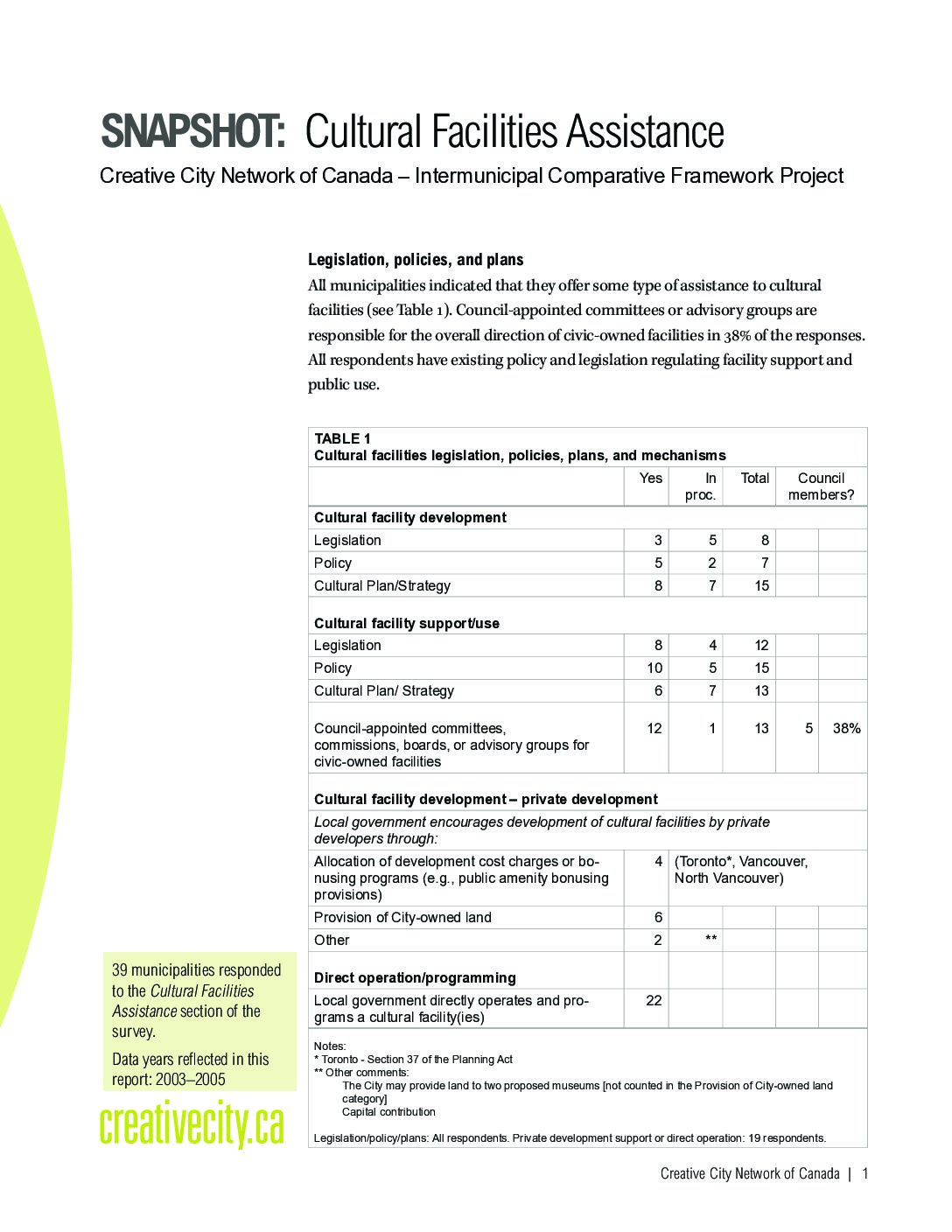
Snapshot: Cultural Facilities Assistance
Legislation, policies, and plans. All municipalities indicated that they offer some type of assistance to cultural facilities. Council-appointed committees or advisory groups are responsible for the overall direction of civic-owned facilities in 38% of the responses. All respondents have existing policy and legislation regulating facility support and public use. 39 municipalities responded to the Cultural Facilities Assistance section of the survey. Data years reflected in this report: 2003–2005
-
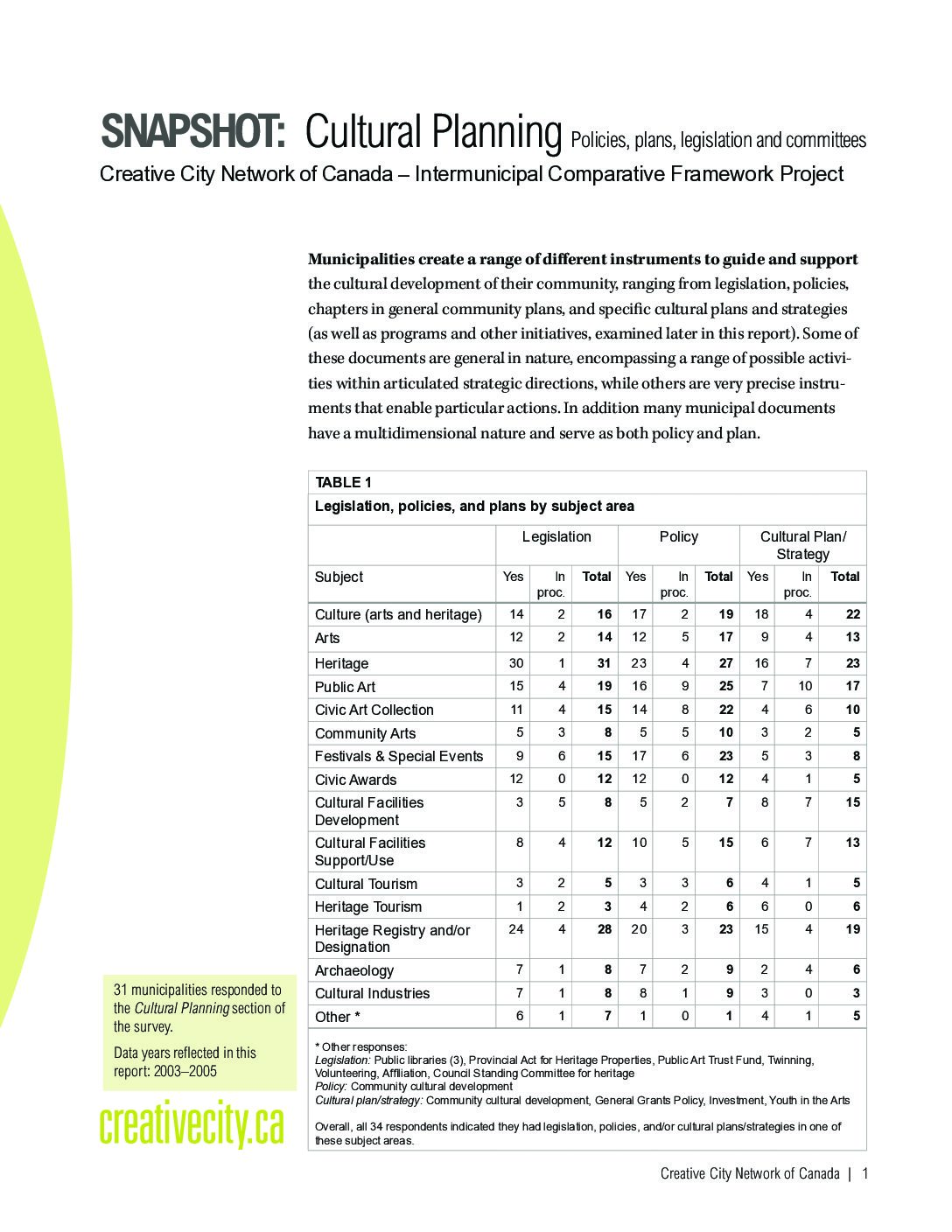
Snapshot: Cultural Planning
Municipalities create a range of different instruments to guide and support the cultural development of their community, ranging from legislation, policies, chapters in general community plans, and specific cultural plans and strategies (as well as programs and other initiatives, examined later in this report). Some of these documents are general in nature, encompassing a range of possible activities within articulated strategic directions, while others are very precise instruments that enable particular actions. In addition many municipal documents have a multidimensional nature and serve as both policy and plan. 31 municipalities responded to the Cultural Planning section of the survey. Data years reflected in this report: 2003–2005
-
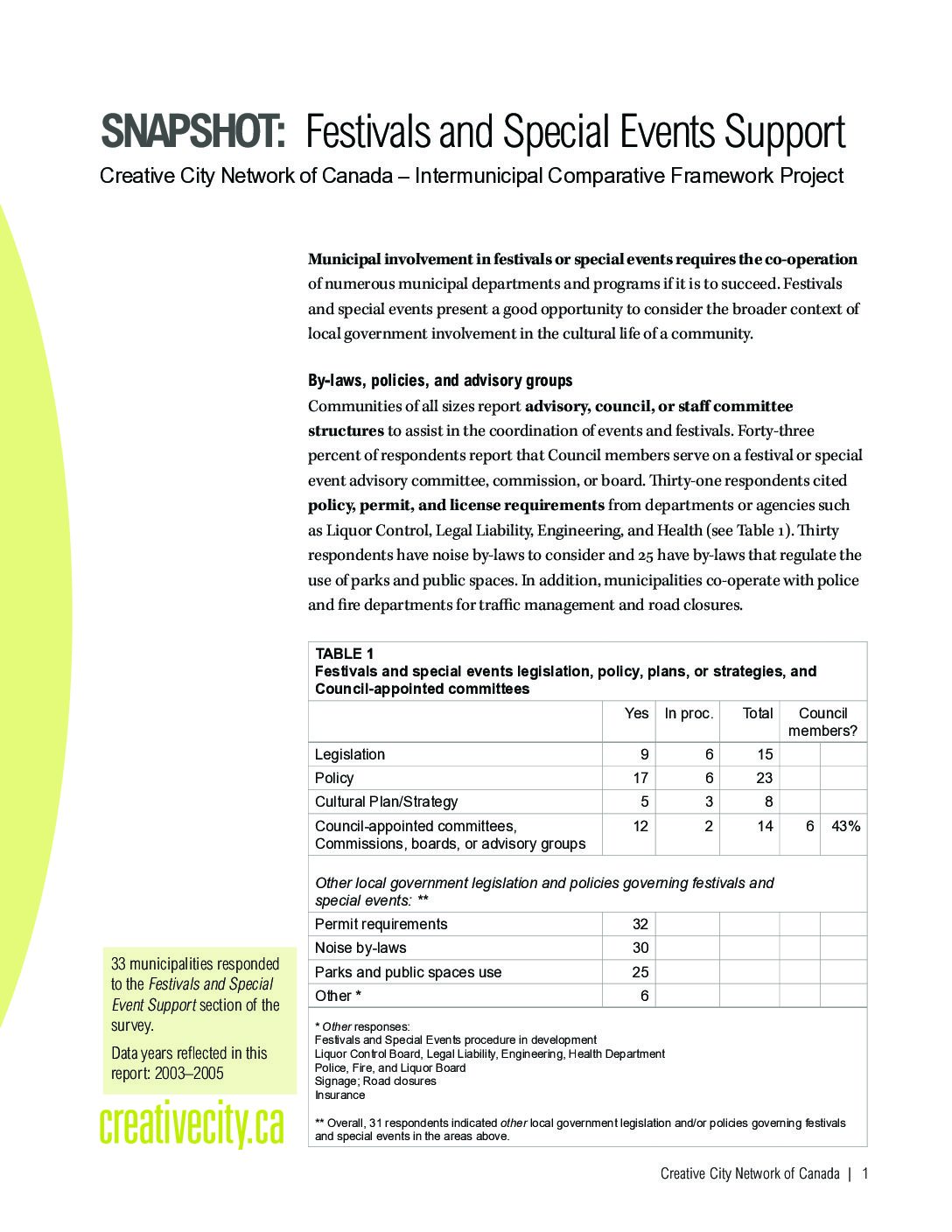
Snapshot: Festivals and Special Events Support
Municipal involvement in festivals or special events requires the co-operation of numerous municipal departments and programs if it is to succeed. Festivals and special events present a good opportunity to consider the broader context of local government involvement in the cultural life of a community.
-
Snapshot: Heritage
Heritage has been in the vanguard of cultural policy and legislation in municipalities across Canada since being given a welcome measure of credibility around the time of the country’s centennial in 1967. One of the earlier pieces of legislation reported in the survey is the 1965 St. Catharines, Ontario By-law to Operate a Museum; in the 1970s there was a flurry of heritage- and archaeology- related legislation and policy.
-
Snapshot: Public Art
Public art programs make art accessible and visible throughout a municipality. Public art serves as an expression of the community, and public sites provide an important venue for everyone to appreciate artwork outside the traditional museum or gallery setting. 38 municipalities responded to the Public Art section of the survey. Data years reflected in this report: 2003–2005
-
-
-
Managing Cultural Services in Canada (PDF)
A survey and inventory of municipal cultural plans/policies, as well as the structure and management of municipal cultural services.
-
Managing Cultural Services in Canada (XLS)
An inventory of civic owned and/or operated cultural facilities whose primary use is for the creation or exhibition of artistic activities (including but not limited to theatres, recital halls, rehearsal spaces, warehouse spaces dedicated to arts programming, amphitheatres, art galleries, art studios. It does not include museums and/or archives, live/work spaces, general parkland or fairgrounds, public art, private or not for profit owned cultural facilities, or community centres unless artistic programming and artistic activities are the primary user).
-
Managing Public Art – 264KB
A survey on municipal public art policies, plans, and programs and an inventory of public art installations in place and in development.
-
-
-
Per capita funding of culture by major municipalities – 46KB (2002)
Prepared for City of Toronto, Culture and Tourism. City of Toronto staff report on the development of per capita funding of culture benchmarks by major municipalities that includes both direct activity and general grant funding.
-
Victoria, BC – Inventory of Local Government Investment in the Arts in the CRD – 129KB (2002)
An inventory of Local Government investment in the Arts in the thirteen municipalities and the electoral areas of the Capital Regional District of British Columbia, October 2002.
-
CCNC Toolkit Suite
Explore tools in Cultural Planning, Public Art, and Cultural Mapping developed for Canadian municipalities.
Making the Case
-
-
Arts and Positive Change in Communities – 1603KB (2005)
Dialogue opens up through the arts because it deals with meanings, addresses emotions, and helps identify and define individuals and the communities where they live.
-
Building Community Identity and Pride – 1170KB (2005)
Culture brings together networks of individuals strengthening social bonds, creating common memories and a democracy in which people want to participate.
-
Culture as an Economic Engine – 253KB (2005)
Growth is inevitable when culture is used as a tool. It brands, creates job growth, spin-off businesses and competition.
-
Personal and Social Development and Youth – 430KB (2005)
Engaging and motivating children and youth is easily accomplished through the arts, promoting their well-being while teaching them empathy and tolerance.
-
Quality of Life/Quality of Place – 904KB (2005)
The arts can create a level playing field, open to all socioeconomic individuals, groups and communities, enabling public participation.
-
References – Arts and Positive Change in Communities – 55KB (2005)
List of References for Arts and Positive Change in Communities
-
References – Building Community Identity and Pride – 48KB (2005)
List of References for Building Community Identity and Pride
-
References – Culture as an Economic Engine – 90KB (2005)
List of References for Making the Case: Culture as an Economic Engine
-
References – Quality of Life/Quality of Place – 74KB (2005)
List of References for Quality of Life/Quality of Place
-
References – Urban Renewal and Revitalization – 87KB (2005)
List of References for Making the Case: Urban Renewal and Revitalization
-
Urban Renewal and Revitalization – 994KB (2005)
A country is made up of many parts, its inhabitants key players. The arts ensure their habitat reflects who they are and how they live.
-
Partnership Research
-
-
An International Literature Review and Inventory of Resources – 5754KB (2009)
Developing and Revitalizing Rural Communities Through Arts and Creativity: An International Literature Review and Inventory of Resources This paper provides an overview of English-language academic research literature and policy related studies with respect to cultural development in rural communities.
-
An International Literature Review and Inventory of Resources in French
Cet article présente une vue d’ensemble de la documentation issue de la recherche universitaire de langue anglaise et d’études portant sur les politiques en matière de développement culturel au sein des collectivités rurales.
-
Annotated Bibliography – 801KB (2009)
Developing and Revitalizing Rural Communities Through Arts and Creativity: Annotated Bibliography
This annotated bibliography is part of the “Developing and Revitalizing Rural Communities Through Arts and Creativity” project, conducted by the Centre for Policy Studies on Culture and Communities at Simon Fraser University, Vancouver, British Columbia, Canada. The project was commissioned by the Creative City Network of Canada and acknowledges the support provided by the Department of Canadian Heritage and Rural Alberta’s Development Fund through the Alberta Recreation and Parks Association.The purpose of this policy is to contribute to Prince George as BC’s Northern Arts Capital, to contribute to the excellent quality of life of its citizens and to help develop and enhance social, environmental and economic opportunities by promoting art in public places.
-
Full Document available in French – 2805KB (2009)
Édifier et dynamiser les collectivités rurales par le biais des arts et de la créativité : Une analyse documentaire
Cet article présente une vue d’ensemble de la littérature issue de la recherche universitaire de langue anglaise et d’études portant sur les politiques en matière de développement culturel au sein des collectivités rurales. -
Summary Overview – 340KB (2009)
The Developing and Revitalizing Rural Communities Through Arts and Creativity project consisted of an international English-language literature review and resource compilation, framed by considerations of “small/rural communities,” “arts,” and “creative activity.” The purpose was to review and assess the state of research and to highlight dominant themes in the literature, both academic and policy-related research/studies.
-
-
-
Landmark Study Sheds Light on Profound Benefits of the Performing Arts – 3214KB(full report) (2013)
Performing arts presenting generates a wide range of benefits for Canadians, the communities they live in and society at large, according to a report prepared by Strategic Moves and released today by the Canadian Arts Presenting Association (CAPACOA). The Value of Presenting: A Study of Performing Arts Presentation in Canada includes a comprehensive historical and contemporary overview of the performing arts ecosystem. It reveals that performing arts are valued by the vast majority of Canadians – across socio-economic differences – and it provides a new perspective on younger Canadians’ interest in live performing arts. Most importantly, the study identifies a broad range of public benefits associated with performing arts presentation, including better health and well-being, greater energy and vitality in communities, and a more caring and cohesive society.
The Value of Presenting: A Study of Performing Arts Presentation in Canada (2011-2013) is the culmination of two years of intensive study and exploration designed to envision performing arts presenters’ current and future roles within the performing arts ecosystem, in their communities and in society at large. This study was commissioned by the Canadian Arts Presenting Association (CAPACOA), in partnership with the regional and other presenting networks and an advisory committee of sector representatives. The research and consultations process was designed and undertaken by Strategic Moves in collaboration with EKOS Research Associates for quantitative surveying. This work represents the largest pan-Canadian study to date in the performing arts presenting field.
-

